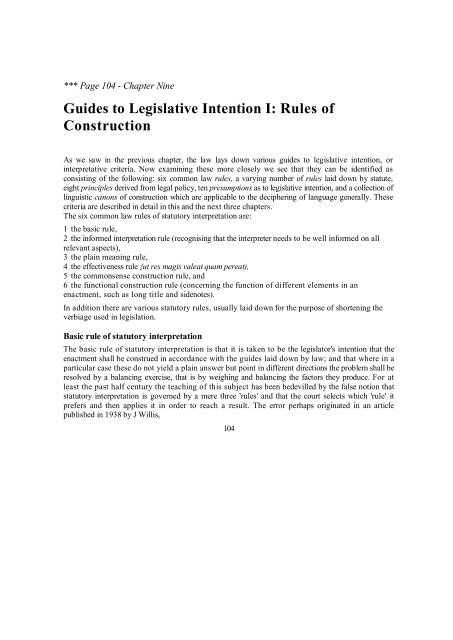Statutory Interpretation The Technique of Statutory ... - Francis Bennion
Statutory Interpretation The Technique of Statutory ... - Francis Bennion
Statutory Interpretation The Technique of Statutory ... - Francis Bennion
You also want an ePaper? Increase the reach of your titles
YUMPU automatically turns print PDFs into web optimized ePapers that Google loves.
*** Page 104 - Chapter Nine<br />
Guides to Legislative Intention I: Rules <strong>of</strong><br />
Construction<br />
As we saw in the previous chapter, the law lays down various guides to legislative intention, or<br />
interpretative criteria. Now examining these more closely we see that they can be identified as<br />
consisting <strong>of</strong> the following: six common law rules, a varying number <strong>of</strong> rules laid down by statute,<br />
eight principles derived from legal policy, ten presumptions as to legislative intention, and a collection <strong>of</strong><br />
linguistic canons <strong>of</strong> construction which are applicable to the deciphering <strong>of</strong> language generally. <strong>The</strong>se<br />
criteria are described in detail in this and the next three chapters.<br />
<strong>The</strong> six common law rules <strong>of</strong> statutory interpretation are:<br />
1 the basic rule,<br />
2 the informed interpretation rule (recognising that the interpreter needs to be well informed on all<br />
relevant aspects),<br />
3 the plain meaning rule,<br />
4 the effectiveness rule {ut res magis valeat quam pereat),<br />
5 the commonsense construction rule, and<br />
6 the functional construction rule (concerning the function <strong>of</strong> different elements in an<br />
enactment, such as long title and sidenotes).<br />
In addition there are various statutory rules, usually laid down for the purpose <strong>of</strong> shortening the<br />
verbiage used in legislation.<br />
Basic rule <strong>of</strong> statutory interpretation<br />
<strong>The</strong> basic rule <strong>of</strong> statutory interpretation is that it is taken to be the legislator's intention that the<br />
enactment shall be construed in accordance with the guides laid down by law; and that where in a<br />
particular case these do not yield a plain answer but point in different directions the problem shall be<br />
resolved by a balancing exercise, that is by weighing and balancing the factors they produce. For at<br />
least the past half century the teaching <strong>of</strong> this subject has been bedevilled by the false notion that<br />
statutory interpretation is governed by a mere three 'rules' and that the court selects which 'rule' it<br />
prefers and then applies it in order to reach a result. <strong>The</strong> error perhaps originated in an article<br />
published in 1938 by J Willis,<br />
104

















